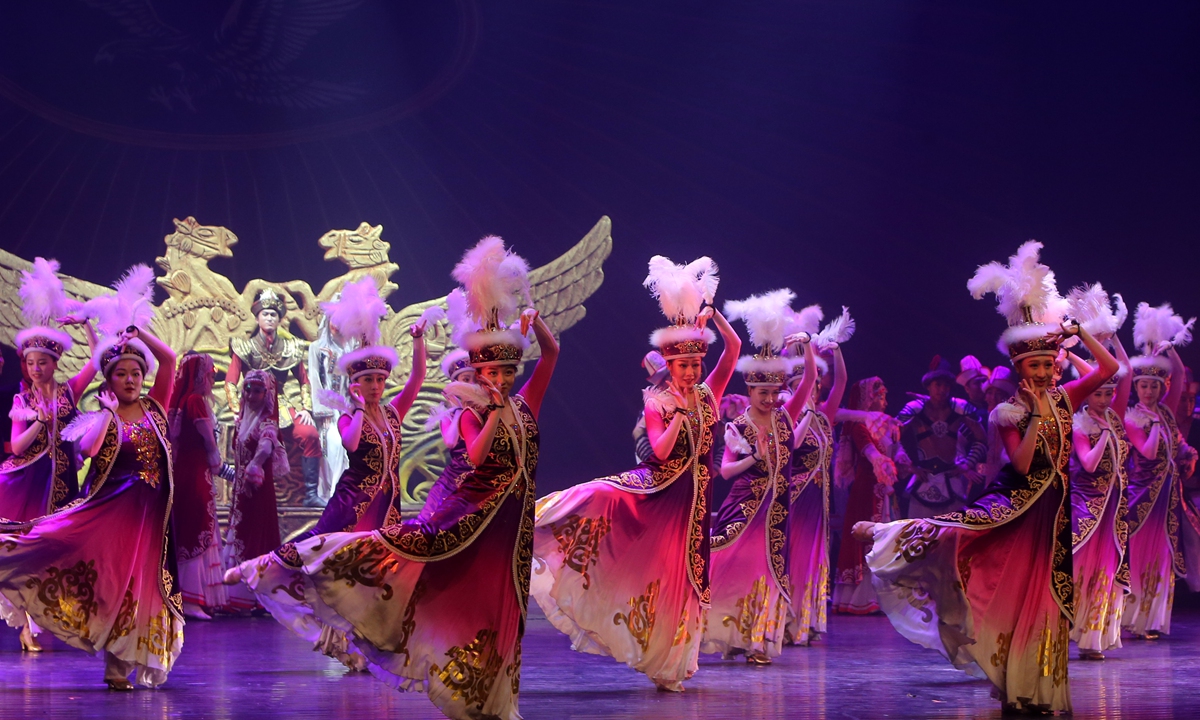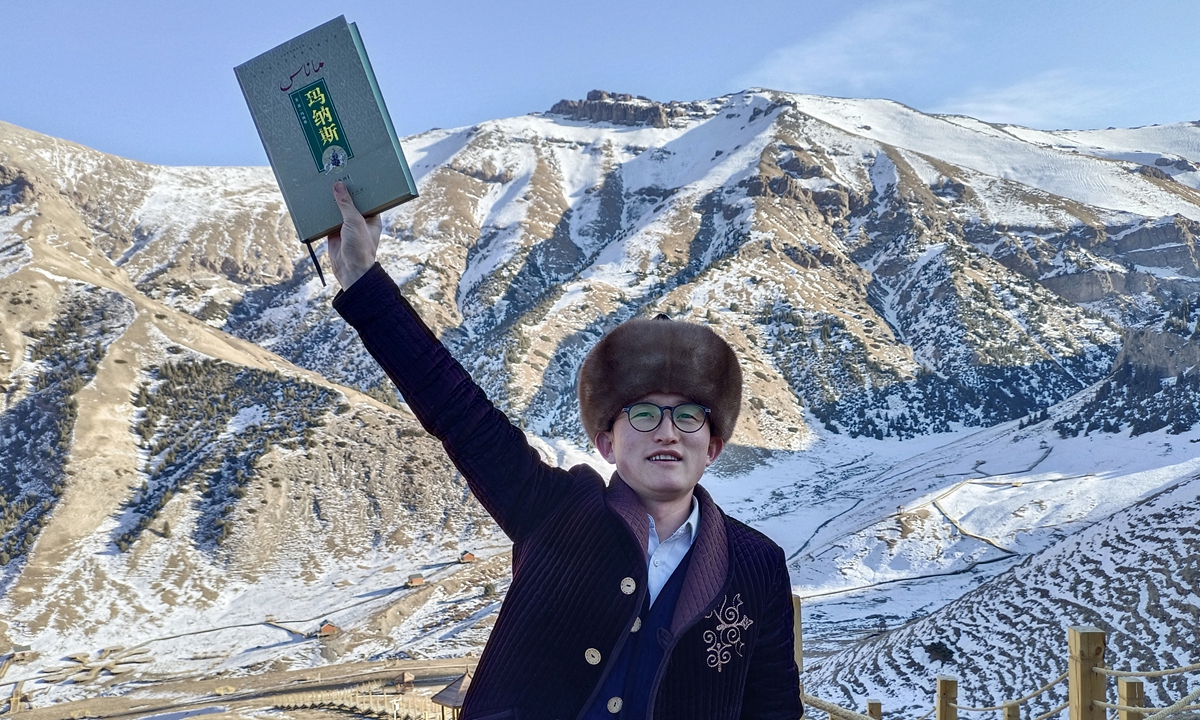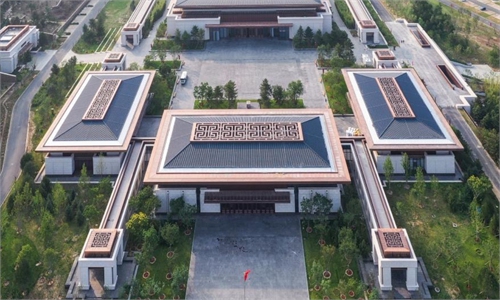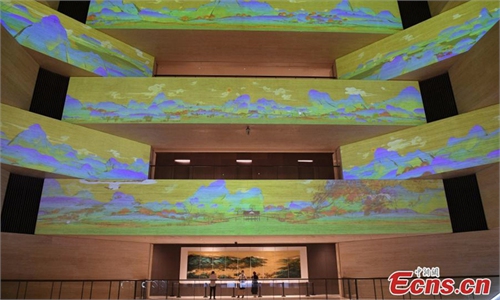ARTS / ART
China's cultural preservation efforts save Kirgiz epic
Down through the centuries

Dancers perform a Kirgiz dance drama based on the Epic of Manas in Xi'an, Shaanxi Province, in September 2018. Photo: IC

Epic of Manas performer Tuohenali Tuxunnali, from Kirgiz ethnic group in China, holds aloft a text edition of the ancient epic. Photo: Courtesy of Tuohenali Tuxunnali
On July 13, a group photo of Chinese President Xi Jinping standing amongst a group of performers of the Epic of Manas - an epic poem dating back to the 16th century that shows the unified spirit of the Kirgiz people - was taken during a special performance of the poem at the Museum of the Xinjiang Uygur Autonomous Region.
At the July performance in Urumqi, Northwest China's Xinjiang Uygur Autonomous Region, Xi emphasized that the cultural legacies of the ethnic minority, such as Epic of Manas, are precious to the entirety of the Chinese nation and should be protected and passed on for their embodiment of China's national spirit.
Tuohenali Tuxunnali, a 28-year-old Manas performer, told the Global Times that Xi's words gave him, one of the epic's young inheritors, more confidence and increased his passion for his ethnic roots.
Ancient tradition
Dubbed a "Homeric tale," the Epic of Manas tells how the Kirgiz hero Manas unified 40 heroes from different nations to fight against invaders.
Tuohenali told the Global Times that the precious singing art has been passed down by Manaschi, Kirgiz bards specializing in the epic, for more than 1,000 years.
"It is an encyclopedia documenting the politics, economy, history, philosophy, culture and social life of the Kirgiz people in ancient times," Tuohenali remarked.
Jusupu Mamayi, Tuohenali's grandfather, was one of the most successful national-level pioneers of the epic in China.
"The epic has more than 230,000 lines and eight episodes. Ever since I was a child, my grandfather would tell me a story from it every day," Tuohenali said.
"My grandfather inherited the culture treasure from his ancestors in the same way. I was told by some other people that to learn the epic's first episode, he sang for seven days straight both day and night."
Though the legendary Manaschi passed away in 2014, the cultural seed he planted in his descendant's heart has grown to become a branching tree that embodies the ethnic group's cultural beliefs.
"In the early days, the Epic of Manas reflected a strong sense of unity among different ethnic groups, especially the spirit of fighting for the interests of the people. This is the pursuit of our young Kirgiz generation as well," he explained.
Tuohenali said that since the epic is a form of art, listeners can clearly sense its heroic elements and the narrative even if they are not familiar with the Kirgiz language.
Conducive to the art's magical power to draw people from different backgrounds together, young Manaschi like Tuohenali are looking for ways to spread the epic with the aim of eliminating prejudice.
"Some Western forces such as the US have accused us of 'eradicating the cultures of minority groups.' As a young inheritor of the Epic of Manas, this really angers me. Singing the Epic of Manas is part of our everyday life, wherever the Kirgiz people are, you can guarantee there will be one of them reciting the Epic of Manas," Tuohenali told the Global Times.
He also said that his grandfather once said, "Without the Communist Party of China, there would be no me today, and without me, there would be no complete version of Manas."
Creative inheritance
To more effectively protect the epic, a census project was launched in China back in the 1960s, during which, many folk inheritors such as Jusupu were located and recorded. In Jusupu's case, his performance of the epic was recorded in 18 volumes of text that were later published.
Following such conservation efforts was the establishment of cultural hubs such as the Manas Research Center in Akqi county, the Kizilsu Kirghiz Autonomous Prefecture. The center displays texts and art, such as sculptures, related to the epic for visitors to enjoy.
However, passing down this legacy requires more than putting it on display in a museum, according to Tuohenali creativity and modern media have major roles to play as well.
"We should pass it on by modern means like novels, dramas, operas, films, animations, TV serials and so on," Tuohenali remarked.
He also plans to add some new contents that depict the contemporary lifestyles of the Kirgiz people as a "prelude" to the epic.
As a Ph.D student researching his cultural roots, Tuohenali said education and international communication can power the conservation of ethnic culture.
"The Epic of Manas also circulates in Kyrgyzstan, Kazakhstan and other countries in Central Asia. It has played a significant role in promoting the implementation of China's Belt and Road Initiative in the cultural field."
"Now I've became a mentor to even younger learners, some born after the 2000s."
Yumitali Yetiku is one such inheritor.
He appears in the photo taken in July standing to the right of Xi.
The 14-year-old middle school student said that his journey to learning the Epic of Manas began when his kindergarten launched interest classes on the epic to get more students interested in traditional Kirgiz culture.



